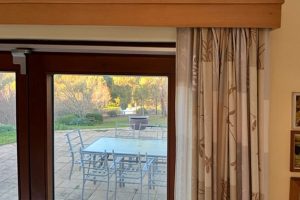Sydney-based interior design studio Atelier Alwill are renowned for crafting contemporary interiors with enduring relevance. The studio’s founder, Romy Alwill, has a background steeped in design. During high school, she lived in Tokyo with her family, which inspired her to pursue a career in design. After studying interior architecture back in Australia, she had a stint living and working overseas before returning home and taking up a position as interior design editor at Belle magazine. In 2005, her years of industry experience culminated in her starting her own studio. In conversation with Romy, we uncovered how her past has moulded her into the designer she is today and how she ultimately approaches design with a focus on the future.

Casa Figueira by Luigi Rosselli Architects and Atelier Alwill | Photography by Prue Ruscoe
Outside of your own practice, how does design have an influence on you?
Romy Alwill: I love seeing how other people design. I find it really refreshing to experience other people’s thinking and tastes. When I’m staying at an Airbnb or in a hotel, for example, it’s interesting to see the different design solutions people have come up with. When something’s done really well, but simply, that’s when design is the most powerful.
Tribute House and Pepper Tree – both collaborations with Luigi Rosselli Architects – are to-date two of the most-viewed projects on est living. How have these projects shaped the way you design in the years since?
Romy Alwill: Both of those projects pushed me in different ways. I found them very challenging then, but I am very proud of them now. In many ways, they were cornerstone projects for us and have shaped the business into what it is today. Because they are quite different from each other, they also showed our potential as a studio – that we’re not just a ‘one-trick pony’. They typify our bespoke approach and demonstrate that we’re not just driven by one aesthetic.

Pepper Tree by Luigi Rosselli Architects and Atelier Alwill | Photography by Prue Ruscoe

Pepper Tree by Luigi Rosselli Architects and Atelier Alwill | Photography by Prue Ruscoe
How do you work with architects like Luigi Rosselli to deliver a seamless design resolution?
Romy Alwill: I enjoy collaborating with architects. The mutual respect that we share produces great outcomes. I’m pretty upfront about my strengths, and they are with theirs, making collaborating seamless from the get-go. In the case of Luigi, we’ve been working together for nearly 15 years, so we have an excellent understanding of what the other has to offer.
What design-related experiences from your time spent living in Tokyo do you draw on today?
Romy Alwill: Living in Tokyo was an eye-opening experience and a dramatic contrast from the Northern Beaches of Sydney. The city is filled with amazing stimuli – everything from what you see to what you taste. In terms of design, everything in Japan is so well considered and meaningful, down to wrapping a gift in a gift shop. Design is so deeply rooted in their culture that everyone appreciates it. In the years since moving back to the Northern Beaches, I’ve strived to replicate some of their philosophies and practices in both my work and everyday life.

Tribute House by Luigi Rosselli Architects and Atelier Alwill | Photography by Prue Ruscoe

Tribute House by Luigi Rosselli Architects and Atelier Alwill | Photography by Prue Ruscoe
Your interiors possess many hallmarks of ‘contemporary Australian’ design, but how do you ensure your projects are also timeless?
Romy Alwill: When designing, we consider how someone will experience the home ten years down the track. We want people to walk into the space and still feel like it’s liveable and current. We do that by, first of all, not being too influenced by trends and, second, incorporating elements that we know will stand the test of time. The Japanese set an excellent example for this; how they design and live in their homes is so considerate of the future.
What are you currently working on? What can we look forward to?
Romy Alwill: We’re working on a few projects at the moment that are pushing us outside of our comfort zone. One is a classic European-style home with a brief to reference 1930s Italian buildings, which we haven’t leaned into much in the past. We’re up for the challenge, as it helps us grow as a business and tap into different parts of our design training.

Twin Peaks by Alwill Architecture and Atelier Alwill | Photography by Prue Ruscoe

Twin Peaks by Alwill Architecture and Atelier Alwill | Photography by Prue Ruscoe
Design Dissected:
Where we get designers’ takes on broader topics, themes or events currently surfacing in the design world.
In today’s design landscape, all designers must strive for maximum impact with minimal intervention. As an interior designer, how do you go about this?
Romy Alwill: As an interior designer, it’s important to stay wary of not just knocking something down for the sake of it because soon we won’t have that luxury. Even if you have the budget to do that, consider whether it’s necessary. Going back to the idea of timelessness, consider its lifespan when introducing a new element to a home; ask yourself, will this last? It just requires a shift in mindset – a shift that is imperative we all make.
Rapid Fire:
Somewhere that inspires you? Japan
Someone that inspires you? Women who can manage it all
Favourite three materials to work with? Paper, stone, linen
Something you want to see more of in design? Less
Something you want to see less of in design? More

Earthship by Luigi Rosselli Architects and Atelier Alwill | Photography by Prue Ruscoe

Cove House by Atelier Alwill | Photography by Prue Ruscoe

Cove House by Atelier Alwill | Photography by Prue Ruscoe
“When we’re designing, we think about how someone will experience the home ten years down the track. We want people to walk into the space then and still feel like it’s liveable and current.”
– Romy Alwill

Sandcastle by Luigi Rosselli Architects and Atelier Alwill | Photography by Prue Ruscoe

Sandcastle by Luigi Rosselli Architects and Atelier Alwill | Photography by Prue Ruscoe





